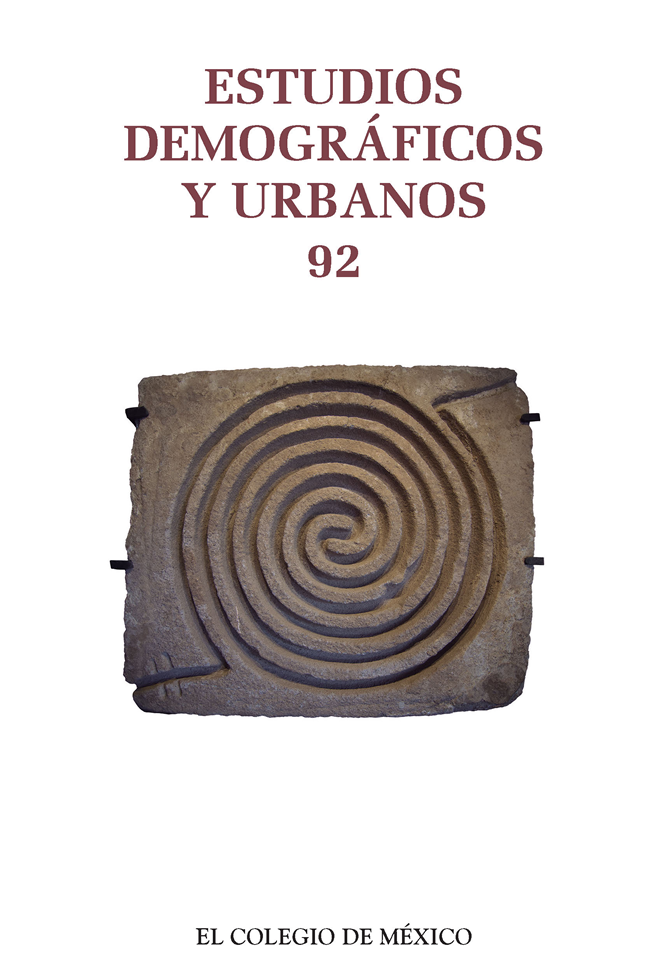Reviewing spatial unit aggregation methods: MAUP, algorithms and a brief example
Published 2016-05-01
Keywords
- spatial aggregation,
- computational algorithms,
- MAUP,
- modifiable area unit problem
How to Cite
-
Abstract1146
-
PDF (español)1741
-
En línea (español)3901
Downloads
Copyright (c) 2016 Estudios Demográficos y Urbanos

This work is licensed under a Creative Commons Attribution-NonCommercial-NoDerivatives 4.0 International License.
Metrics
Abstract
Spatial aggregation methods have generated interest in recent years due to their ease of adaptation to different objectives. Moreover, there are statistical reasons to support their use: they reduce the bias caused by the modifiable area unit problem (MAUP). This article presents a bibliographical review of this issue and the different aggregation methods, together with the application of an algorithm to data from the Metropolitan Area of the Valley of Mexico.
References
- Aerts, Jeroen y Gerard Heuvelink (2002), “Using simulated annealing for resource allocation”, International Journal of Geographical Information Science, vol. 16, núm. 6, pp. 571-587. Disponible en: http://www.tandfonline.com/doi/abs/10.1080/13658810210138751 (27 de mayo de 2014). DOI: https://doi.org/10.1080/13658810210138751
- Aguilar, Adrián y Pablo Mateos (2011), “Diferenciación sociodemográfica del espacio urbano de la Ciudad de México”, Eure, vol. 37, núm. 110, pp. 5-30. Disponible en: http://www.scielo.cl/pdf/eure/v37n110/art01.pdf (9 de junio de 2014). DOI: https://doi.org/10.4067/S0250-71612011000100001
- Aguilar, Adrián y Peter Ward (2003), “Globalization, regional development, and mega-city expansion in Latin America: analyzing Mexico City’s peri-urban hinterland”, Cities, vol. 20, núm. 1, pp. 3-21. Disponible en: http://www.sciencedirect.com/science/article/pii/S0264275102000926 (9 de junio de 2014). DOI: https://doi.org/10.1016/S0264-2751(02)00092-6
- Andersson, Martin y Urban Grasjö (2009), “Spatial dependence and the representation of space in empirical models”, The Annals of Regional Science, vol. 43, núm. 1, pp. 159-180. Disponible en: http://link.springer.com/article/10.1007%2Fs00168-008-0211-5#/page-1 (14 de noviembre de 2013). DOI: https://doi.org/10.1007/s00168-008-0211-5
- Anselin, Luc (1988), “The formal expression of spatial effects”, en Luc Anselin, Spatial Econometrics: Methods and Models, Boston, Kluwer Academic Publishers, pp. 16-31. DOI: https://doi.org/10.1007/978-94-015-7799-1_3
- Anselin, Luc (1999), “Spatial econometrics”, documento de trabajo, Bruton Center, School of Social Sciences, University of Texas. Disponible en: http://www.csiss.org/learning_resources/content/papers/baltchap.pdf (27 de mayo de 2014).
- Ariza, Marina y Patricio Solís (2009), “Dinámica socioeconómica y segregación espacial en tres áreas metropolitanas de México, 1990 y 2000”, Estudios Sociológicos, vol. 27, núm. 79, pp. 171-209. Disponible en: http://www.redalyc.org/articulo.oa?id=59820689006 (16 de febrero de 2014). DOI: https://doi.org/10.24201/es.2009v27n79.266
- Armstrong, Marc, Panos Lolonis y Rex Honey (1993), “A spatial decision support system for school redistricting”, Journal of the Urban and Regional Information Systems Assoociation, vol. 5, pp. 40-52. Disponible en: https://www.researchgate.net/publication/255782392_A_spatial_decision_support_systemfor_school_redistricting (27 de mayo de 2014).
- Bergey, Paul, Cliff Ragsdale y Mangesh Hoskote (2003), “A simulated annealing genetic algorithm for the electrical power districting problem”, Annals of Operations Research, vol. 121, núm. 1-4, pp. 33-55. Disponible en: http://link.springer.com/article/10.1023%2FA%3A1023347000978#/page-1 (16 de febrero de 2014).
- Bozkaya, Burcin, Erhan Erkut y Gilbert Laporte (2003), “A tabu search heuristic and adaptive memory procedure for political districting”, European Journal of Operational Research, vol. 144, núm. 1, pp. 12-26. Disponible en: http://www.sciencedirect.com/science/article/pii/S0377221701003800 (13 de septiembre de 2013). DOI: https://doi.org/10.1016/S0377-2217(01)00380-0
- Brody, Howard, Michael Russell, Peter Vinten-Johansen, Nigel Paneth y Stephen Rachman (2000), “Map-making and myth-making in broad street: The London cholera epidemic, 1854”, The Lancet, núm. 356, pp. 64-68. Disponible en: http://www.uio.no/studier/emner/matnat/ifi/INF5761/v12/undervisningsmateriale/map_making_myth_making%281%29.pdf (9 de junio de 2014). DOI: https://doi.org/10.1016/S0140-6736(00)02442-9
- Chiquiar, Daniel (2005), “Why Mexico’s regional income covergence broke down?”, Journal of Development Economics, vol. 77, núm. 1, pp. 257-275. Disponible en: http://www.sciencedirect.com/science/article/pii/S0304387804001580 (13 de septiembre de 2013). DOI: https://doi.org/10.1016/j.jdeveco.2004.03.009
- D’Amico, Steven, Shoou-Jiun Wang, Rajan Batta y Christopher Rump (2002), “A simulated annealing approach to police districting design”, Computer and Operations Research, vol. 29, núm. 6, pp. 667-684. Disponible en: http://www.sciencedirect.com/science/article/pii/S0305054801000569 (14 de noviembre de 2013). DOI: https://doi.org/10.1016/S0305-0548(01)00056-9
- Delgadillo, Javier y Felipe Torres (2011), Estudios regionales en México: aproximaciones a las obras y sus autores, México, Instituto de Investigaciones Económicas, Universidad Nacional Autónoma de México.
- Duque Cardona, Juan Carlos (2004), “Design of homogenous territorial units. A methodological proposal and applications”, tesis de doctorado en Estudios Empresariales, Barcelona, Departamento de Econometría Estadística y Economía Española, Universidad de Barcelona.
- Duque, Juan Carlos, Manuel Artís y Raúl Ramos (2006), “The ecological fallacy in a time series context: Evidence from Spanish regional unemployment rates”, Journal of Geographic Systems, vol. 8, núm. 4, pp. 391-410. Disponible en: http://link.springer.com/article/10.1007%2Fs10109-006-0033-x#/page-1 (27 de mayo de 2014). DOI: https://doi.org/10.1007/s10109-006-0033-x
- Duque, Juan Carlos, Raúl Ramos y Jordi Suriñach (2007), “Supervised regionalization methods: a survey”, International Regional Science Review, vol. 30, núm. 3, pp. 195-220. Disponible en: http://irx.sagepub.com/content/30/3/195.full.pdf+html (9 de junio de 2014). DOI: https://doi.org/10.1177/0160017607301605
- Duque, Juan Carlos, Luc Anselin y Sergio Rey (2012), “The Max-P regions problem”, Journal of Regional Science, vol. 52, núm. 3, pp. 397-419. Disponible en: http://onlinelibrary.wiley.com/doi/10.1111/j.1467-9787.2011.00743.x/epdf (14 de noviembre de 2014). DOI: https://doi.org/10.1111/j.1467-9787.2011.00743.x
- Duque, Juan Carlos, Vicente Royuela y Miguel Noreña (2012), “A stepwise procedure to determinate a suitable scale for the spatial delimitation of urban slums”, en Esteban Fernández y Fernando Rubiera (coords.), Defining the Spatial Scale in Modern Regional Analysis, Oviedo-Berlín, Springer / Heidelberg, pp. 237-254. DOI: https://doi.org/10.1007/978-3-642-31994-5_12
- Esquivel, Gerardo (1999), “Convergencia regional en México, 1940-1995”, El Trimestre Económico, vol. 66, núm. 264, pp. 725-761. Disponible en: http://www.jstor.org/stable/20857005?seq=1#page_scan_tab_contents (16 de febrero de 2014).
- Freedman, David (2001), “Ecological inference and the ecological fallacy”, en International Encyclopedia for the Social and Behavioral Sciences, Elsevier, pp. 4027-4030. DOI: https://doi.org/10.1016/B0-08-043076-7/00410-1
- García, Reyna y Lizbeth Salgado (2014), “La identidad regional como factor de integración: una reflexión”, Invurnus, vol. 9, núm. 1, pp. 3-9. Disponible en: http://www.invurnus.uson.mx/revistas/articulos/16-Garc%C3%ADa%20y%20Salgado20141.pdf (16 de febrero de 2014).
- Gasca, José (2009), Geografía regional: la región, la regionalización y el desarrollo regional en México, México, Instituto de Investigaciones Económicas, Universidad Nacional Autónoma de México.
- Gauvin, Lise, Éric Robitaille, Mylène Riva, Lindsay McLaren, Clément Dassa y Louise Potvin (2007), “Conceptualizing and operationalizing neighbourhoods. The conundrum of identifying territorial units”, Canadian Journal of Public Health- Revue Canadienne de Santé Publique, vol. 98, núm. 1, pp. S18-S26. Disponible en: https://www.researchgate.net/publication/5801091_Conceptualizing_and_operationalizing_neighbourhoods_The_conundrum_of_identifying_territorial_units (27 de mayo de 2014). DOI: https://doi.org/10.1007/BF03403723
- Gotway, Carol y Linda Young (2002), “Combining incompatible spatial data”, Journal of the American Statistical Association, vol. 97, núm. 458, pp. 632-648. Disponible en: http://www.tandfonline.com/doi/abs/10.1198/016214502760047140 (14 de noviembre de 2013). DOI: https://doi.org/10.1198/016214502760047140
- Hansen, Pierre, Brigitte Jaumard, Christophe Meyer, Bruno Simeone y Valeria Doring (2003), “Maximum split clustering under connectivity constraints”, Journal of Classification, vol. 20, núm. 2, pp. 143-180. Disponible en: http://link.springer.com/article/10.1007%2Fs00 357-003-0011-7#page-1 (9 de junio de 2014). DOI: https://doi.org/10.1007/s00357-003-0011-7
- Hanson, Gordon (2003), “What happened to wages since NAFTA? Implications for hemispheric free trade”, Working Paper, núm. 9563, National Bureau of Economic Research. Disponible en: http://www.nber.org/papers/w9563 (9 de junio de 2014). DOI: https://doi.org/10.3386/w9563
- Hojati, Mehran (1996), “Optimal political districting”, Computers and Operations Research, vol. 23, núm. 12, pp. 1147-1161. Disponible en: http://rangevoting.org/Hojati.pdf (27 de mayo de 2014). DOI: https://doi.org/10.1016/S0305-0548(96)00029-9
- Horn, Mark (1995), “Solution techniques for large regional partitioning problems”, Geographical Analysis, vol. 27, núm. 3, pp. 230-248. Disponible en: http://onlinelibrary.wiley.com/doi/10.1111/j.1538-4632.1995.tb00907.x/pdf (9 de junio de 2014). DOI: https://doi.org/10.1111/j.1538-4632.1995.tb00907.x
- Indriasary, Vini, Ahmad Rodzi, Noordin Ahmad y Abdul Rashid (2010), “Maximal service area problem for optimal siting of emergency facilities”, International Journal of Geographical Information Science, vol. 24, núm. 2, pp. 213-230. Disponible en: http://www.tandfonline.com/doi/abs/10.1080/13658810802549162 (16 de febrero de 2014). DOI: https://doi.org/10.1080/13658810802549162
- INEGI (2010), Censo de Población y Vivienda 2010, Aguascalientes, Instituto Nacional de Estadística y Geografía. Disponible en: http://www.censo2010.org.mx (14 de noviembre de 2013).
- Iracheta, Alfonso (2002), “Notas sobre desarrollo y planeación regional en México”, en Javier Delgadillo y Alfonso Iracheta (coords.), Actualidad de la investigación regional en el México central, México, Centro Regional de Investigaciones Multidisciplinarias, Universidad Nacional Autónoma de México / El Colegio Mexiquense / El Colegio de Tlaxcala / Plaza y Valdés.
- Iracheta, Alfonso (2010), Evaluación del Fondo Metropolitano 2006-2009, México, El Colegio Mexiquense.
- Iracheta, Alfonso y José Iracheta (2014), Evaluación de los fondos metropolitano y regional del gobierno federal mexicano, México, CIDE / Centro CLEAR para América Latina / SHCP / BID / Colegio Mexiquense / Centro Eure.
- Lankford, Phillip (1969), “Regionalization: theory and alternative algorithms”, Geographical Analysis, vol. 1, núm. 2, pp. 196-212. Disponible en: http://onlinelibrary.wiley.com/doi/10.1111/j.1538-4632.1969.tb00615.x/pdf (27 de mayo de 2014). DOI: https://doi.org/10.1111/j.1538-4632.1969.tb00615.x
- Moreno, Pilar y Jesús García (2011), “Estado del arte en procesos de zonificación”, GeoFocus, núm. 11, pp. 155-181. Disponible en: http://geofocus.rediris.es/2011/Articulo7_2011.pdf (9 de junio de 2014).
- Neme, Omar, J.R.G. Pulido y Antonio Neme (2011), “Mining the city data: making sense of cities with self-organizing maps”, en Advances in Self-Organizing Maps: Proceedings of the 8th International Workshop, WSOM 2011, Espoo, 13 a 15 de junio, pp. 168-177. DOI: https://doi.org/10.1007/978-3-642-21566-7_17
- Openshaw, Stan (1977), “A geographical solution to scale and aggregation problems in region-building, partitioning and spatial modeling”, Transactions of the Institute of British Geographers, vol. 2, núm. 4, pp. 459-472. Disponible en: http://www.jstor.org/stable/622300?seq=1#page_scan_tab_contents (14 de noviembre de 2013). DOI: https://doi.org/10.2307/622300
- Openshaw, Stan (1984), The Modifiable Areal Unit Problem, Norwich, GeoBooks.
- Openshaw, Stan y Liang Rao (1995), “Algorithms for reengineering 1991 Census Geography”, Environment and Planning, vol. 27, núm. 3, pp. 425-446. Disponible en: http://epn.sagepub.com/content/27/3/425.abstract (16 de febrero de 2014). DOI: https://doi.org/10.1068/a270425
- Pérez, Enrique y Clemencia Santos (2011), “Diferenciación socioespacial en la Zona Metropolitana de la Ciudad de México”, Investigaciones Geográficas, núm. 74, pp. 92-106. Disponible en: http://www.scielo.org.mx/scielo.php?script=sci_arttext&pid=S0188-46112011000100008 (16 de febrero de 2014).
- Rey, Sergio y Myrna Sastré-Gutiérrez (2010), “Interregional inequality dynamics in Mexico”, Spatial Economic Analysis, vol. 5, núm. 3, pp. 277-298. Disponible en: http://www.tandfonline.com/doi/abs/10.1080/17421772.2010.493955 (27 de mayo de 2014). DOI: https://doi.org/10.1080/17421772.2010.493955
- Rey, Sergio, Luc Anselin, David Folch, Daniel Arribas-Bel, Myrna Sastré-Gutiérrez y Lindsey Interlante (2011), “Measuring spatial dynamics in metropolitan areas”, Economic Development Quarterly, vol. 25, núm. 1, pp. 54-64. Disponible en: http://edq.sagepub.com/content/25/1/54.full.pdf+html (14 de noviembre de 2013). DOI: https://doi.org/10.1177/0891242410383414
- Ríos-Mercado, Roger y Elena Fernández (2009), “A reactive GRASP for a commercial territory design problem with multiple balancing requirements”, Computers and Operations Research, vol. 36, núm. 3, pp. 755-776. Disponible en: http://www.sciencedirect.com/science/article/pii/S0305054807002249 (16 de febrero de 2014). DOI: https://doi.org/10.1016/j.cor.2007.10.024
- Santé-Riveira, Inés, Marcos Boullón-Magán, Rafael Crecente-Maseda y David Miranda-Barrós (2008), “Algorithm based on simulated annealing for land-use allocation”, Computers & Geosciences, vol. 34, núm. 3, pp. 259-268. Disponible en: http://www.sciencedirect.com/science/article/pii/S0098300407001458 (14 de noviembre de 2013). DOI: https://doi.org/10.1016/j.cageo.2007.03.014
- Tiede, Dirk y Josef Strobl (2006), “Polygon-based regionalisation in a GIS environment”, en Erich Buhmann, Stephen Ervin, Ian Jorgensen y Josef Strobl (coords.), Trends in Knowledge-Based Landscape Modeling, Heidelberg, Wichmann-Verlag.
- Voß, Stephan (2001), “Metaheuristics: the state of the art”, Lecture Notes in Computer Science, núm. 2148, pp. 1-23. Disponible en: http://link.springer.com/chapter/10.1007%2F3-540-45612-0_1#page-1 (9 de junio de 2014).
- Wang, Jue, Mei-Po Kwan y LinBing Ma (2014), “Delimiting service area using adaptive crystal-growth Voronoi diagrams based on weighted planes: a case study in Haizhu District of Guangzhou in China”, Applied Geography, vol. 50, pp. 108-119. Disponible en: http://www.sciencedirect.com/science/article/pii/S0143622814000514 DOI: https://doi.org/10.1016/j.apgeog.2014.03.001
- Zoltners, Andris y Prabhakant Sinha (1983), “Sales territory alignment: a review and model”, Management Science, vol. 29, núm. 11, pp. 1237-1256. Disponible en: http://pubsonline.informs.org/doi/abs/10.1287/mnsc.29.11.1237?journalCode=mnsc (27 de mayo de 2014). DOI: https://doi.org/10.1287/mnsc.29.11.1237


